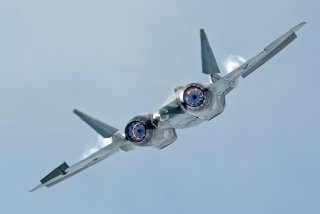Russia Thinks It Can Kill F-35 Stealth Fighters in a War. Hubris.
Magomed Tolboyev, a renowned test pilot, says not only would Russia win, it wouldn't even be close.
Here's What You Need to Remember: "Su-57 will kill [an F-35] easily, should they meet one on one," Tolboyev told Tass. "The F-35 cannot maneuver, it's simply incapable. But it does has electronic might."
The United States military's Lockheed Martin F-35 Lightning II Joint Strike Fighter is considered one of the most deadly and capable aircraft anywhere in the world today and it has been suggested it is unrivaled as well. However, at least one Russian test pilot has suggested that the F-35 would be no match for Russia's own Sukhoi Su-57.
While both are fifth-generation, multirole fighters designed to destroy all types of air, ground, and naval targets, Magomed Tolboyev, a renowned test pilot who celebrated his 70th birthday on January 20, said that the Russian Su-57 would have the advantage were it to face an F-35 in a one-on-one dogfight.
Maneuverability would be the Sukhoi-built aircraft's greatest advantage, according to Tolkoyev, who boasted that it would not be a close fight either.
"Su-57 will kill [an F-35] easily, should they meet one on one," Tolboyev told Tass. "The F-35 cannot maneuver, it's simply incapable. But it does has electronic might."
However, even that advantage would be easily disrupted by solar flares Tolkoyev added, noting "This is why I oppose everything electronic."
A retired major general, Tolboyet is also an honored test pilot and has been awarded the title of Hero of Russia. During his service, he piloted more than 50 types and modifications of Russian military aircraft including the MiG-29, MiG-31, Su-24 and Su-27. In the mid-1980s, Tolboyev also participated in the Energia-Buran space program where he underwent a full training course for manned space flights on multiple-use spacecraft.
In his career, he also studied the concept of dogfights and it is worth noting that when he was born in 1951, the North American F-86 Sabre took on MiG-15s in such aerial combat sorties over Korea. And while he also praised the Su-57 as a "brilliant plane," but suggested the time of such one-on-one dogfights are essentially a thing of the past.
"Today, you no longer fight one on one," Tolkoyev added. "Everything depends on your support. There is electronic warfare today. This is no longer a sparring tatami, but a complex approach to tactical issues."
The Su-57 is currently entering service with the Russian Air Force. It features supersonic cruising, internal weapon bay, radio absorptive coating, and the newest avionics complex. All of it is beyond the technology that Tolkoyev may be unfamiliar with, and if anything the aircraft's platform is only getting more advanced.
In December it was announced that the first batch-produced Su-57 fighter was also used for testing of hypersonic weapons at a test flight test center in Akhtubinsk.
Additionally, last month, Defense Minister Sergei Shoigu told the Defense Ministry's board meeting that a total of 22 Su-57 jets would be provided for the Russian armed forces by the end of 2024. Under a contract signed in 2019, a total of 76 Su-57 jets are to be supplied by the end of 2028. Starting from 2022 the Su-57 jets will be equipped with second-stage engines.
Peter Suciu is a Michigan-based writer who has contributed to more than four dozen magazines, newspapers and websites. He regularly writes about military small arms, and is the author of several books on military headgear including A Gallery of Military Headdress, which is available on Amazon.com.
Image: Reuters

